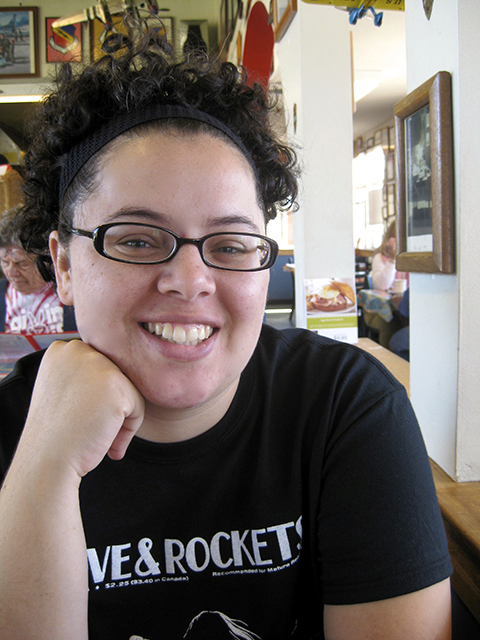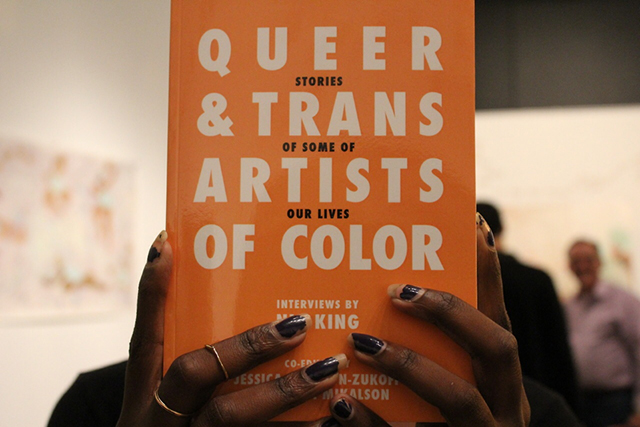How do you make it as an artist? After Nia King left a full-time job to be an artist, she wanted to hear other people’s success stories, particularly those with the most marginalized voices — queer and trans people of color.

King produces the podcast We Want the Airwaves, in which she interviews artists of all disciplines in her ongoing search for the key to “making it” as an artist. In 2014 King self-published a collection of the podcast interviews in the book Queer and Trans Artists of Color: Some of Our Stories. The transcribed interviews, much like the podcast, relay the artists’ experiences with refreshing honesty and surprising amounts of humor. The artists share candid and vulnerable tales of life, many about using art as tool against oppression.
King’s interviews serve not only to document the existence of marginalized cultural creators, but assert the power and vibrancy of queer and trans artists working today. Only one year later, King is self-publishing a second volume of Queer and Trans Artists of Color. I sat down with her to ask how the podcast got started, what she learned about making it as an artist, and why this work remains important to her.
How did the idea for your podcast come about?
It stemmed partially from growing up in punk rock and activist communities, having the DIY ethic to go make something on your own. Before the podcast, I made zines. Most of my early zines were about race and my experiences being mixed.
After I graduated from Mills College, my focus changed from personal stories to what it meant to make a living as an artist. I knew I wanted to create a platform for other artists who were not getting the attention they deserved, like queer and trans people of color.
How did you go from zines to the podcast?
I went through the Queer Women of Color Media Arts Project and learned how to edit video. I had the idea to do a podcast, but wasn’t sure what it would be about yet. After interning at Colorlines, I realized I wanted to talk to artists I saw as successful — to find out how they did it. Specifically, I wanted to talk to artists who were queer and trans people of color (QTPOC), because the advice my white male mentor at the time gave me didn’t feel applicable to my life as a queer woman of color.
Where did you get the title, We Want the Airwaves?
It’s from a Ramones song, which goes back to my punk rock roots. It’s also a demand for access to the media and an insistence on the right for marginalized people to take up space.

What was the process of self-publishing like?
The few presses I approached either rejected it or didn’t get back to me. I didn’t want to wait around for someone to say that it was good enough to be published. It comes back to punk and DIY. I just wanted to go do it. I’ve never received a grant for any of my work. It’s all been self-funded or crowd-funded.
What does “making it” as an artist mean?
I wanted to ask, “What’s the secret?” to unlock the code to making it as an artist. But I learned that there’s no single “trick” to making it. Art school is supposed to help, but I work with a lot of art school grads at my minimum wage day job.
The formula for success is some combination of hard work, talent, hustle, privilege and luck. The ratios are different for everyone.
What are the common threads throughout the interviews?
Many queer and trans artists of color have day jobs, many do low-wage labor, or sex work. Sometimes a combination of both.
People love to say that if you work hard and put your nose down on the grindstone and make good work, eventually you’ll get discovered. But first of all, what does “getting discovered” even mean anymore? I used to think that you only hustle until you get your big break, but now I realize you hustle until you die.
How do you select the artists for your podcast?
It began with who I knew. My first interview was with Virgie Tovar, who I met back in 2013 when we both performed in Berkeley for Michelle Tea’s RADAR Productions. I was impressed with Virgie’s work and asked, “Hey, can I interview you for this podcast that doesn’t exist yet?” After that, whenever I saw work that impressed me, I reached out to the artist.
I want the podcast to represent the full diversity of the QTPOC community. Sometimes I notice a specific demographic is underrepresented in my podcast… I use social media to ask my friends involved in queer and trans artists of color communities, “Who is making good work right now?”
Is there anything you’ll do differently for the second volume of Queer and Trans Artists of Color?
Last time, I gave the artists three chances to approve their interviews before the book went to press. This time they will sign off only at the final stage to reduce the workload.
I do the same with every interview for the podcast. The artists get a chance to listen to their own interview before it airs. If they want me to change anything, I will. I think about how this content is going to be out there forever. It’s about protecting my community. When traditional media turns an eye on marginalized communities, it tends to be exploitive. My goal is to not reproduce that kind of hurtful stuff.
What’s at stake for you in producing the podcast and books?
This past year put everything in perspective for me, with all the anti-Black police violence and so many murders of trans women of color. With QTPOC, there is a high risk of violence, murder and suicide. There are also the things that kill us slowly, like not having access to safe housing, jobs and health care.
In my book introduction, I wrote that this archive was important because I was worried about folks going broke and not making work anymore. But it’s also because their lives might end. I feel lucky that all of the artists in the first book are still alive today.
Art is a political necessity for marginalized people. We have an urgent message to get across, which is that we were here and that our lives matter.